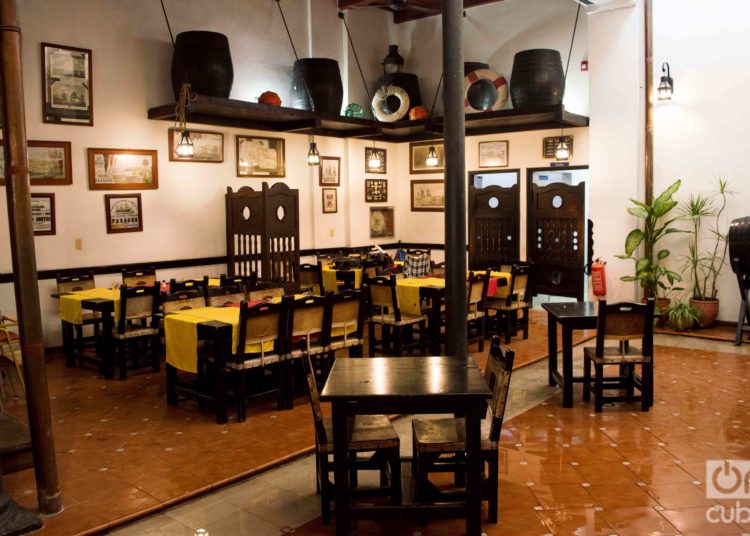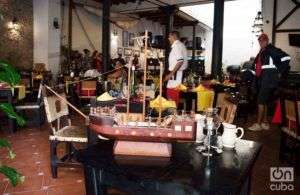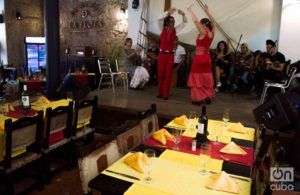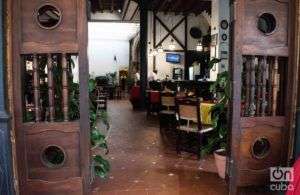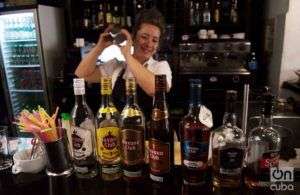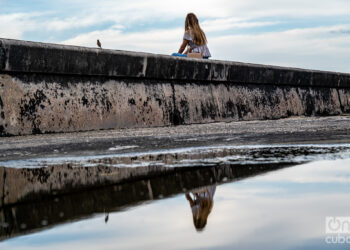It is necessary to agree with Federico García Lorca. “There is no map or exercise to search for magic.”
Described in Andalusia as a mysterious and ineffable charm, the magic ran away to America more than five centuries ago in Columbus’ expeditions and right now we detect it, very much alive, in the musicians and dancers that liven up the evenings and nights in El Mesón de la Flota. Do they fan the guitar? / Yes. / And they play the string guitar? / Also, and without capo. / And do they sing without music? / Well, sometimes. / And the cante jondo? / That’s always present. Soleares, seguiriyas or tonás, whatever you want. / With jaleo or without jaleo? / With a lot of jaleo. / And the dancers? / The magic is always with them.
That could well be the imaginary dialogue between a connoisseur of flamenco music and the group performing a season at El Mesón de la Flota flamenco bar.
Located at 257 Mercaderes Street, on the first floor of the small hostel (bearing the same name) with five spacious rooms, the Mesón evokes the traditional Spanish inn that proliferated in the accesses to the port of the township of San Cristóbal de La Habana during the first centuries of the colony, where the Atlantic fleets of the Spanish empire stopped for supplies.
The atmosphere is seafaring, Of course. Replicas of old ships, flags of the sign codes, nets, astrolabes, telescopes, wheels, notifications about transatlantic steam ships, cargo and passengers, making a stopover in Caribbean ports, and barrels and ropes and sails collected in yards.
And clients, no matter where they come from and no matter for how long, while listening to flamenco can taste exquisite dishes – always featuring seafood – together with Spanish tapas and an international wine cellar, in addition to Cuban and Spanish desserts. And afterwards, rounding it off by deifying the most demanding palate: a cup of hot Cuban coffee, cultivated in the humid and arborescent eastern mountains.
“We’ll keep you company with our music, even when there’s only one table with clients,” says Eduardo Betancourt, percussionist and flamenco singer of the group De Rocío, one of the many that cultivate flamenco and alternate with others in the Mesón, like Ecos, the company that represents the Andalusian genre with the most orthodoxy and talent.
Eduardo is an affable young man. He confidently tells about his encounter with flamenco. It has been empirical. He used to sing different genres, “traditional Cuban music,” he says, until he saw a video and heard the duet of El Cigala and Cuban pianist Bebo Valdés.
Electrifying? “Well, of course. After that I could do nothing else and here I am.”
Eduardo takes advantage of a halt in the music to talk with me. As a percussionist, he comes from the ranks of traditional Cuban music, the one with which Buena Vista Social Club created a musical Arcadia, where publics that were in the antipodes shook hands, be they neoliberals or communists, Jews or Muslims.
The vocalist had the privilege of setting foot in Amor de Dios, one of the Madrid schools for the teaching of flamenco. There, as a listener during the lessons, he met María Juncal, who has been in Cuba through the Compás Flamenco community project.
“I am thankful to that company for everything I now know,” says the artist, who afterwards has tried singing other genres and “that flamenco lilt has always remained with me.”
The genre is demanding every day. “The melisma, so varied, are very difficult,” he admits, while he tries to create his own style, far from El Cigala or Camarón. And let’s not mention the vocal demands. “You have to brutally crack your voice.”
The De Rocío Company presents a particular format. A guitarist, three women dancers, the lead singer and percussion, and a female violinist, whose instrument acquires the category of exotic (or intruder) in this type of music that emerged, as we know, in the 18th century.
A graduate from diverse musical academies, Aylen Mendoza knows how to play Bach, Beethoven and Paganini, as well as salsa, but she preferred flamenco, a genre that assimilates “very well the creativity the instrument can offer.”
“You have to add a bit of yourself to the classical themes of the genre, always respecting the folkloric base of each flamenco palo,” Mendoza explains.
“All the optional instruments have been adapted to flamenco based on fusions. For example, we play jazz. Everything is possible here,” affirms Eduardo Betancourt, without a hint of boasting.
Slight, quiet, discreet, it seems impossible that a 22-year-old girl like Marina Tremearde has significant strength in her legs as a dancer. Her stamping on the flamenco stage speaks of an unsuspected energy.
She started off in Spanish dance when she was four years old, with no family tradition, except for a mother who wanted to please her small daughter and keep her busy.
“I’ve always liked Spanish dance, no other,” she affirms without a shadow of a doubt. She has been a dancer with De Rocío for a year and she confesses that the command of the castanets has taken her almost a lifetime. “You have to practice with them every day.”
Marina affirms that “while she has the strength, will and health” she will continue dancing, and she specifies that of all the instruments, the cajón is the one that makes her vibrate with the most intensity. “My ear pays attention to the cajón,” she reiterates.
Visited by giants of the genre like Paco de Lucía, Antonio Gades and Cristina Hoyos, Cuba is a sanctuary for thousands of fans of the genre.
Festivals like the Imprint of Spain or professional companies like Lizt Alfonso Dance and the Ballet Español de Cuba, among others, and musicians like Raynier Mariño, keep alive the flamenco scene in the middle of a Caribbean glazed by rhythms from all parts of the world.
Although she speaks highly of the quality of the Cuban flamenco musicians, for Marina “the roots are the roots,” alluding to the Spanish exponents who, however, as Eduardo bears witness to, say that some Cuban musicians are the same or better than the Spanish ones in terms of flamenco music.
“They are amazed when they see us here, in the Mesón, because they can’t conceive that such a quality cante can exist in Cuba. I can say that without thinking twice,” and he adds a phrase that even if it is a set one is not less authentic: “It’s in our blood.”
Eduardo gets ready for another palo. He will include the classical Lágrimas negras, by Cuban Miguel Matamoros, with a flamenco rhythm, of course; some traditional Andalusian song by Jeréz, and he’s thinking about a contemporary touch with Corazón partío, by Sanz.
“The rest is up to what the public will tell us,” the flamenco singer affirms, looking at the hardwood stage where the stamping of feet has almost sunk some of the boards, like beautiful scars. It’s the passion that doesn’t know how to pretend, anyone would say, including Lorca, of course!


